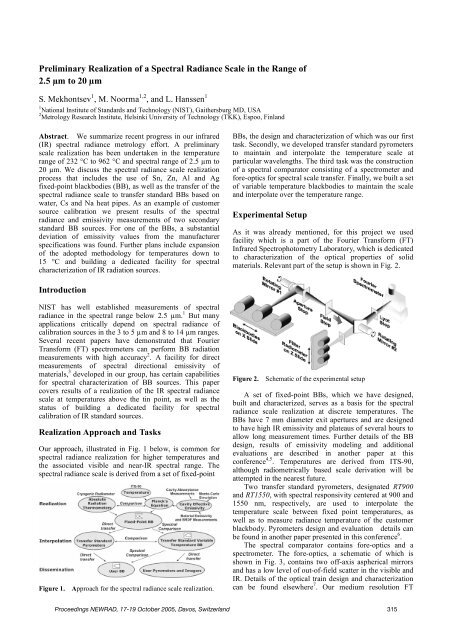Here - PMOD/WRC
Here - PMOD/WRC
Here - PMOD/WRC
You also want an ePaper? Increase the reach of your titles
YUMPU automatically turns print PDFs into web optimized ePapers that Google loves.
Preliminary Realization of a Spectral Radiance Scale in the Range of<br />
2.5 m to 20 m<br />
S. Mekhontsev 1 , M. Noorma 1,2 , and L. Hanssen 1<br />
1 National Institute of Standards and Technology (NIST), Gaithersburg MD, USA<br />
2 Metrology Research Institute, Helsinki University of Technology (TKK), Espoo, Finland<br />
Abstract. We summarize recent progress in our infrared<br />
(IR) spectral radiance metrology effort. A preliminary<br />
scale realization has been undertaken in the temperature<br />
range of 232 °C to 962 °C and spectral range of 2.5 m to<br />
20 m. We discuss the spectral radiance scale realization<br />
process that includes the use of Sn, Zn, Al and Ag<br />
fixed-point blackbodies (BB), as well as the transfer of the<br />
spectral radiance scale to transfer standard BBs based on<br />
water, Cs and Na heat pipes. As an example of customer<br />
source calibration we present results of the spectral<br />
radiance and emissivity measurements of two secondary<br />
standard BB sources. For one of the BBs, a substantial<br />
deviation of emissivity values from the manufacturer<br />
specifications was found. Further plans include expansion<br />
of the adopted methodology for temperatures down to<br />
15 °C and building a dedicated facility for spectral<br />
characterization of IR radiation sources.<br />
BBs, the design and characterization of which was our first<br />
task. Secondly, we developed transfer standard pyrometers<br />
to maintain and interpolate the temperature scale at<br />
particular wavelengths. The third task was the construction<br />
of a spectral comparator consisting of a spectrometer and<br />
fore-optics for spectral scale transfer. Finally, we built a set<br />
of variable temperature blackbodies to maintain the scale<br />
and interpolate over the temperature range.<br />
Experimental Setup<br />
As it was already mentioned, for this project we used<br />
facility which is a part of the Fourier Transform (FT)<br />
Infrared Spectrophotometry Laboratory, which is dedicated<br />
to characterization of the optical properties of solid<br />
materials. Relevant part of the setup is shown in Fig. 2.<br />
Introduction<br />
NIST has well established measurements of spectral<br />
radiance in the spectral range below 2.5 m. 1 But many<br />
applications critically depend on spectral radiance of<br />
calibration sources in the 3 to 5 m and 8 to 14 m ranges.<br />
Several recent papers have demonstrated that Fourier<br />
Transform (FT) spectrometers can perform BB radiation<br />
measurements with high accuracy 2 . A facility for direct<br />
measurements of spectral directional emissivity of<br />
materials, 3 developed in our group, has certain capabilities<br />
for spectral characterization of BB sources. This paper<br />
covers results of a realization of the IR spectral radiance<br />
scale at temperatures above the tin point, as well as the<br />
status of building a dedicated facility for spectral<br />
calibration of IR standard sources.<br />
Realization Approach and Tasks<br />
Our approach, illustrated in Fig. 1 below, is common for<br />
spectral radiance realization for higher temperatures and<br />
the associated visible and near-IR spectral range. The<br />
spectral radiance scale is derived from a set of fixed-point<br />
Figure 1.<br />
Approach for the spectral radiance scale realization.<br />
Figure 2.<br />
Schematic of the experimental setup<br />
A set of fixed-point BBs, which we have designed,<br />
built and characterized, serves as a basis for the spectral<br />
radiance scale realization at discrete temperatures. The<br />
BBs have 7 mm diameter exit apertures and are designed<br />
to have high IR emissivity and plateaus of several hours to<br />
allow long measurement times. Further details of the BB<br />
design, results of emissivity modeling and additional<br />
evaluations are described in another paper at this<br />
conference 4,5 . Temperatures are derived from ITS-90,<br />
although radiometrically based scale derivation will be<br />
attempted in the nearest future.<br />
Two transfer standard pyrometers, designated RT900<br />
and RT1550, with spectral responsivity centered at 900 and<br />
1550 nm, respectively, are used to interpolate the<br />
temperature scale between fixed point temperatures, as<br />
well as to measure radiance temperature of the customer<br />
blackbody. Pyrometers design and evaluation details can<br />
be found in another paper presented in this conference 6 .<br />
The spectral comparator contains fore-optics and a<br />
spectrometer. The fore-optics, a schematic of which is<br />
shown in Fig. 3, contains two off-axis aspherical mirrors<br />
and has a low level of out-of-field scatter in the visible and<br />
IR. Details of the optical train design and characterization<br />
can be found elsewhere 7 . Our medium resolution FT<br />
Proceedings NEWRAD, 17-19 October 2005, Davos, Switzerland 315
















